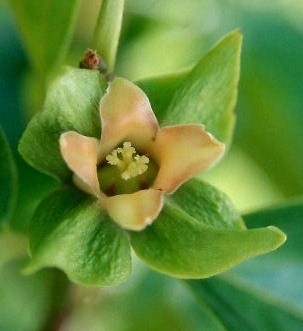Broadleaf ebony
(Diospyros maritima)

Description
Diospyros maritima (commonly known as the Malaysian persimmon, broadleaf ebony and sea ebony is a tree in the family Ebenaceae. The specific epithet maritima means "by the sea", referring to the tree's habitat. Diospyros maritima grows up to 15 metres (50 ft) tall. The inflorescences bear up to 10 flowers. The fruits are round, up to 1.7 cm (1 in) in diameter. Diospyros maritima grows up to 15 metres (50 ft) tall. The inflorescences bear up to 10 flowers. The fruits are round, up to 1.7 cm (1 in) in diameter Diospyros maritima is native to an area from Japan and Taiwan to Malesia and northern Australia. Its habitat is coastal forests Diospyros is a genus of over 700 species of deciduous and evergreen trees and shrubs. The majority are native to the tropics, with only a few species extending into temperate regions. Individual species valued for their hard, heavy, dark timber, are commonly known as ebony trees, while others are valued for their fruit and known as persimmon trees. Some are useful as ornamentals and many are of local ecological importance. Species of this genus are generally dioecious, with separate male and female plants. The generic name Diospyros comes from a Latin name for the Caucasian persimmon (D. lotus), derived from the Greek dióspyros, from diós and pyrós. The Greek name literally means "Zeus's wheat" but more generally intends "divine food" or "divine fruit". Muddled translations sometimes give rise to curious and inappropriate interpretations such as "God's pear" and "Jove's fire". The genus is a large one and the number of species has been estimated variously, depending on the date of the source. The Royal Botanic Gardens, Kew, list has over 1000 entries, including synonyms and items of low confidence. Over 700 species are marked as being assigned with high confidence. Diospyros species are important and conspicuous trees in many of their native ecosystems, such as lowland dry forests of the former Maui Nui in Hawaii,Caspian Hyrcanian mixed forests, Khathiar–Gir dry deciduous forests, Louisiade Archipelago rain forests, Madagascar lowland forests, Narmada Valley dry deciduous forests, New Caledonian sclerophytic vegetation, New Guinea mangroves or South Western Ghats montane rain forests. The green fruits are rich in tannins and thus avoided by most herbivores; when ripe they are eagerly eaten by many animals however, such as the rare Aders' duiker (Cephalophus adersi).
Taxonomic tree:







